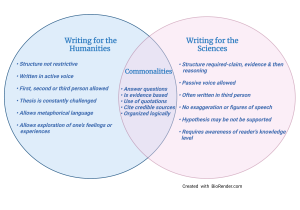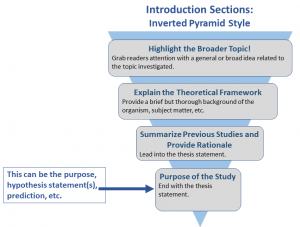1 Writing for the Sciences
1.1 Learning to Write Scientifically
Part of conducting effective research is learning to communicate scientific findings in a clear and concise manner. In this activity, you will be asked to critically read examples of undergraduate biology writing, and apply the principles learned to your own writing. You will also complete exercises to sharpen your understanding of the required conventions in scientific writing.
Figure 1
Venn diagram showing the similarities and differences between writing for the Sciences and writing for the Humanities

1.2 What is a Lab Report Introduction?
To address this question, we need to consider the following:
- What is the purpose of an Introduction section in a formal lab report?
- How might scientists use an Introduction section to highlight the importance of their study?
If applicable, an Introduction section also includes a statement of the null (H0) and alternative hypotheses (HA) using the proper scientific conventions. The null hypothesis states that the independent variable has no effect on the dependent variable. This is the hypothesis you are testing in your experiment. The alternative hypothesis is a tentative answer to your research question (e.g., the independent variable has an effect on the dependent variable).
You should also include a prediction (i.e., a statement of the specific trend you expect to observe). The prediction describes the expected relationship between your independent and dependent variable. You should be able to provide sound justification for the reasoning behind your prediction by referencing background information or the findings of other researchers (usually peer reviewed literature) to add credibility to the prediction. Remember, to avoid using terms like “prove”, “verify” or “demonstrate the truth” in a lab report. Instead use terms like “set out to investigate/test”, “document” or “describe”. It is important to be open minded during a study/experiment.
A good Introduction section should progress from more general statements/information to more specific information about the chemical(s), organism selection, tests, etc. then finish with the specific objective(s) of the experiment (See Figure 2).
Figure 2
An inverted pyramid style of showing how to write an Introduction section of a lab report

1.3 Activity on understanding the components of an Introduction section
Complete the quiz below to test your comprehension of this chapter’s content:
